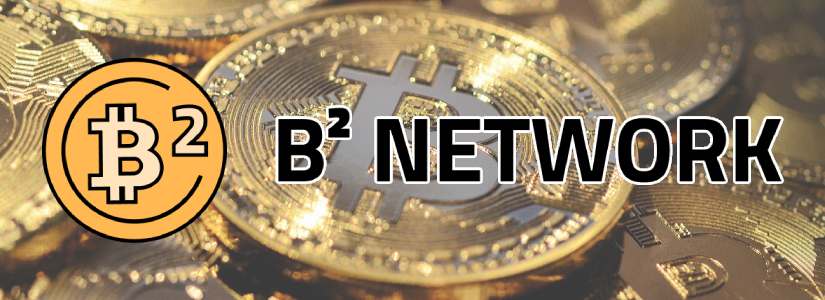Do you want to earn rewards while staking your Bitcoins? Then B² Network may be exactly what you need. In this article, we will see how this platform is opening up a world of opportunities for BTC holders and how you can use it.
What is B² Network?

B² Network (BSquared) is a Layer-2 scaling solution designed specifically for the Bitcoin blockchain. Using zero-knowledge proof (zk proof) technology, it improves transaction efficiency while maintaining the high level of security that Bitcoin is known for. At its core, B² Network is based on a zk proof verification rollup, enabling faster, cheaper and more secure transactions without overloading the main chain.
One of its most prominent features is support for the Ethereum Virtual Machine (EVM). This integration allows developers to create and migrate decentralized applications (DApps) to B² Network, thus expanding Bitcoin’s use cases beyond simple payments. The network supports both Bitcoin and Ethereum addresses, facilitating user interaction across multiple blockchain ecosystems.
B² Network’s mission is to transform Bitcoin into a versatile platform capable of supporting advanced applications such as Decentralized Finance (DeFi), Non-Fungible Tokens (NFTs) and Social Finance (SocialFi). In doing so, it expands Bitcoin’s utility, evolving it from being simply a store of value to a dynamic environment for digital assets and diverse applications.
B² Network’s focus on fast transaction speeds, low fees and robust security through zk testing offers a practical solution for both individual and enterprise users seeking efficient on-chain interactions. In addition, B² Network seeks to revive the culture of Bitcoin developers, encouraging innovation and development by providing tools and resources, facilitating their contribution to the growth of the network.
What is B² Network Buzz?
B² Buzz is a user rewards activity launched by B² Network, which combines the concept of mining with the culture of the Bitcoin ecosystem. This event aims to offer an immersive experience where participants can deposit various assets and earn rewards through the generation of “mining rig parts”, which are used to assemble virtual mining machines.
Users start by registering and connecting their wallet to the platform, where they can deposit cryptocurrencies such as BTC, BRC20, ETH, USDC, and other supported assets. As participants deposit, they earn pieces of mining rigs, and these rewards are influenced by the amount and duration of deposits, as well as the number of people invited to participate.
The system encourages team participation through an invitation and collaboration mechanic, where users can form teams and receive additional benefits. And with each milestone reached, treasure boxes containing more rewards are unlocked.
As users assemble their mining rigs, these machines (categorized into CPUs, GPUs and ASICs) generate computational power, which translates into additional rewards in the form of network-native tokens.
B² Hive: Bitcoin Staking on B²

B² Hive is the staking functionality within the B² Network platform, designed to allow users to block Bitcoin (BTC) in exchange for receiving rewards. By participating in this process, not only do you get the native B² token as an incentive, but you also contribute to the security of the network by validating B² Network transactions. Users who choose to stake BTC in the B² Hub PoS receive proportional rewards in B² tokens according to the amount of BTC they staked.
In addition to token rewards, participants in B² staking also engage in Babylon’s security mechanism, a Bitcoin completion provider that reinforces the security of both the B² Hub and Babylon. This model allows BTC stakers to collaborate in keeping the network secure, while gaining additional benefits. In addition, the Hive protocol can be integrated into third-party applications, expanding opportunities to earn rewards and participate in various staking scenarios.
We take a look at how B² works

B² Network is designed to improve scalability and efficiency while maintaining security through a multi-layered architecture. This architecture is composed of two main components: the Rollup Layer and the Data Availability Layer.
The Rollup Layer uses a ZK-Rollup (Zero Knowledge Rollup) system, specifically with the zkEVM solution, which is responsible for executing user transactions within the second layer network. In this layer, user transactions are sent, processed and stored. In addition, proofs of these transactions are generated using Zero Knowledge cryptography, which guarantees privacy and efficiency. These proofs, along with batch proposals, are sent to the Data Availability Layer.
At the Data Availability Layer, the architecture combines decentralized storage solutions, specialized B² nodes and the Bitcoin network itself. Decentralized storage acts as a secure repository for all transaction data and their respective proofs, improving security by distributing data across multiple locations and reducing the risk of a single point of failure.
B² Nodes play a key role in this layer, performing various functions, such as validating zero-knowledge proofs, storing copies of rollup data and ensuring transaction integrity. They operate under a delegated proof-of-stake (DPoS) model to select sequencers, avoiding power centralization and reducing the risk of malicious actions. These nodes also handle Bitcoin data integration into B² rollups, using Bitcoin’s Proof of Work (PoW) algorithm for final confirmations. They interact with the Bitcoin Network via Tapscript to record rollup data, verify proofs, and ensure that all transactions are finalized securely on the Bitcoin blockchain.
Finally, the Bitcoin Network acts as the ultimate settlement layer. By utilizing the network’s robust PoW mechanism, users can retrieve all transactions from B² rollups, verify them through zero-knowledge proofs and ensure their authenticity. This integration provides a solid security foundation, leveraging Bitcoin’s well-established network while enabling more efficient scalability through the B² second-layer solution.
Conclusion
The Bitcoin blockchain has made significant advances in its utility starting with the emergence of Babylon and, subsequently, projects that build on the latter to expand the possibilities for investors. That is the case of B² Network, which has innovated through attractive reward systems that seek to diversify the opportunities offered by BTC.